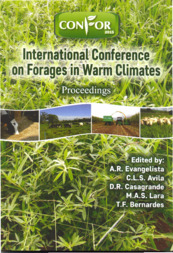Using mathematical models to simulate growth and future scenarios of tropical grasslands.
Using mathematical models to simulate growth and future scenarios of tropical grasslands.
Author(s): SANTOS, P. M.; PEZZOPANE, J. R. M.; PEDROSO, T. de A.; BOSI, C.; GALHARTE, C.; ANDRADE, A. S. de; PEDREIRA, B.; MARIN, F.
Summary: Global temperature may increase by up to 4.8°C until 2100, according to predictions from the Fifth Assessment Report (AR5) ofthe Intergovernmental Pane1on Climate Change (IPCC, 2013). According to Calzadilla et al. (2013), global agricultural production is expected to decrease by 0.5% in the medium and 2.3% in the long termo Besides that, the distribution of harvested land is expected to change, implying modifications on production and intemational trade patterns (Calzadilla et al., 2013). In Brazil, global climatic changes are supposed to influence agriculture, which is responsible for 22% ofthe Brazilian gross national product (CEPEA, 2013),Adaptation ofproduction systems and mitigation of greenhouse gas emissionsare the main challenges imposed by global climate changes to agriculture.
Publication year: 2015
Types of publication: Paper in annals and proceedings
Keywords: GLOBAL TEMPERATURE, MATEMATHICAL, tropical grasslands
Observation
Some of Embrapa's publications are published as ePub files. To read them, use or download one of the following free software options to your computer or mobile device. Android: Google Play Books; IOS: iBooks; Windows and Linux: Calibre.
Access other publications
Access the Agricultural Research Database (BDPA) to consult Embrapa's full library collection and records.
Visit Embrapa Bookstore to purchase books and other publications sold by Embrapa.

